Abstract
This research focuses on the dynamic mix of students at international schools, where native English speakers and English as an additional language (EAL) students study English together. The study aims to explore how teaching practices are currently applied to both groups of learners, assess learning attainment in English lessons, and propose future developments in instructional approaches. Using a phenomenological qualitative research approach, 23 primary and secondary teachers from an international school were selected through convenience sampling to participate in three focus groups. Discussions centered around current teaching methods, methods of measuring learning attainment, and strategies for further improvement. The study found that peer support and translation emerged as consistent and effective approaches for teaching both native and EAL students. Assessment was a prominent theme concerning student attainment, and suggestions for improvement included differentiation, addressing individual learning needs, and revising enrollment requirements to better accommodate diverse ability levels. This research contributes to understanding teachers’ perceptions regarding the integration and treatment of native and EAL students in English lessons and provides valuable insights for designing inclusive teaching practices and recommending policy developments.
1. Introduction
Understanding the advantages and disadvantages experienced by native English speakers and EAL students in English lessons is crucial for educators to adapt their instructional practices effectively. Given the ever-changing educational landscape and diverse learning scenarios, teachers must consider individual circumstances while formulating educational approaches and policies []. Flockton and Cunningham [] argue that implementing teaching approaches suitable for both sets of learners can be challenging, prompting further investigation into the differences in learning experiences between them. Bailey and Sowden [] suggest that teachers’ knowledge of how to incorporate students’ home language, vocabulary, and reading skills can be enhanced through continuous professional development (CPD) courses.
This research aimed to explore how primary and secondary English teachers at an international school perceive learning attainment among native English and EAL students. The study sought to identify potential differences in students’ abilities to grasp information presented in their English lessons. It delved into the factors that might benefit or limit each group’s approach to learning, retention of information, and comprehension of lesson content. While academic achievement relies on factors like grit and determination, this study concentrated on how teachers view the role of language proficiency in the students’ learning experiences [].
Native English-speaking students may have an advantage in English lessons due to their greater familiarity with the language. Bogulski et al. [] suggest that bilingual language learning involves different processing mechanisms, influencing how each set of learners comprehends new information in various learning scenarios. Conversely, EAL students bring additional qualities to the classroom, such as, according to Gardener’s motivation theory, motivation, which may contribute to their overall academic achievement []. Dos Santos [] emphasizes the teacher’s responsibility to apply appropriate methodologies and theoretical approaches to ensure equal opportunities for all learners in the classroom.
In this context, this study aimed to investigate the learning retention differences between native English speakers and EAL students, as perceived by teachers at an international school. The research sought to analyze the positive and negative effects experienced by each learner group in English lessons. The main research question was:
How do primary and secondary education English teachers at an international school experience the learning attainment of native English and EAL students?
The sub-questions include the following:
Which teaching approaches do English teachers adopt for native English and EAL students?
What kind of evidence do they have regarding the learning attainment of both groups?
What support do they need to enhance the attainment of both groups of students?
What proposals do they have to ensure equal opportunities for both groups when studying the English language?
The research questions and sub-questions of the study were influenced by the above-mentioned [,] references that highlight important aspects related to English as an additional language (EAL) students’ learning and teaching practices in a diverse classroom setting. Specifically, the reference to Gardner’s motivation theory [] suggests that EAL students bring unique qualities to the classroom, including motivation. Elaborating on this theory would involve discussing how Gardner’s theory posits that motivation is a crucial factor in language learning. The sub-questions related to teaching approaches and evidence of learning attainment include references to how teachers harness motivational factors to enhance the learning experience for both native and EAL students. This theory underscores the need to explore teaching methods that cater to different types of motivation and the ways in which these approaches affect students’ language acquisition. The reference to Dos Santos’s work [] emphasizes the teacher’s responsibility to employ appropriate methodologies and theoretical approaches to ensure equal opportunities for all students. This reference’s influence on the research questions is reflected in the sub-questions that inquire about teaching approaches, evidence of learning attainment, and proposals for equal opportunities. This includes investigating the strategies teachers use to provide equal learning opportunities, accommodate varying proficiency levels, and create an inclusive environment.
By addressing these questions, the study aimed to shed light on teacher perceptions, helping educators develop more inclusive and effective teaching practices for both native and EAL students in English lessons.
2. Review of the Literature
This section delves into the current understanding of native English speakers and English as an additional language (EAL) students in the classroom, the teaching approaches employed at international schools, and perspectives on educational attainment and the relationship between language and educational needs.
2.1. Literature Search Strategy
To gather relevant literature for this study, a comprehensive search strategy was employed, covering various topics, such as native English and EAL students in English lessons, international schools, learning attainment, and teacher perceptions. Priority was given to peer-reviewed and contemporary journal articles, as they offer a more reliable and synthesized approach compared to individual studies [,]. The authors leveraged resources from the university library, incorporating articles sourced from various databases, including Scopus and the ISI Web of Knowledge. They also consulted Google Scholar, Academia, and ResearchGate to access additional open-access resources. Search filters were applied to ensure that publications from 2018 onwards were included to capture the most up-to-date information due to the dynamic nature of educational systems [,,].
2.2. English as a Foreign Language and EAL Learners
Teaching English as an additional language (EAL) learners presents a range of challenges and expectations for educators in their teaching practice. Ensuring that teachers possess up-to-date and applicable skills is crucial for the successful integration of EAL learners alongside native English speakers in English lessons []. The effectiveness of teaching the English language lies in employing interactive and engaging methods, an idea supported by Kane et al., who found that learners who engaged in game-based learning platforms and play-based teaching methods achieved higher learning attainment []. However, it is important to note that not all teaching approaches need to be solely interactive or play-based to achieve desired learning outcomes. Chalmers argues that tailoring teaching methods to the individual learner and the specific scenario is of utmost importance for successful information retention [].
Several factors must be considered when evaluating the factors influencing students’ ability to attain information effectively. This includes understanding what information is attainable for a given set of learners and setting appropriate thresholds for learning objectives. Creagh et al. and Kane et al. emphasize the importance of further research to support educational policy decisions and funding allocations related to learning attainment in EAL education, including the use of play-based activities [,]. On the other hand, other researchers highlight the significance of learning analytics and consistent communication during transitions between schools to ensure proper construction, development, progress, and monitoring of learning attainment in EAL education [,].
Teachers must carefully consider the implications and advantages of native English-speaking students learning alongside EAL learners in the classroom. It is essential for educators to adapt their teaching practices accordingly to meet the needs of both sets of learners and achieve equal learning success []. While interactive teaching approaches are beneficial for both sets of learners, as indicated by Babayigit and Shapiro and Kosar and Bedir, cultural and educational backgrounds play a significant role in affecting learners’ ability to retain information at the same rate [,]. Chumak-Horbatsch and Conteh argue that prior educational experiences and environments also impact learners’ ability to achieve results at a comparable level to their academic peers [,].
Assessing learning attainment within language teaching can be achieved through various tasks, including speaking, listening, reading, or writing comprehension assessments. Listening and reading comprehension assessments offer accessibility and reliability for educators in gathering data from multiple students. Costley et al. found that both monolingual and EAL students performed similarly in a testing scenario among French students, highlighting the equality and reliability of assessing mixed-group linguistic learners in terms of learning attainment []. However, other researchers such as Sinclair and Lau and Hamed and Fadhil indicate that various variables, such as school policies and classroom environments, significantly impact educational outcomes [,].
2.3. Educational Attainment and the Relationship between Language and Educational Needs
Language proficiency plays a critical role in students’ comprehension and understanding of lesson concepts and approaches. Analyzing and understanding how learners’ language comprehension affects their ability to attain information can lead to the further development and evolution of professional practice []. Demie’s research concluded that the level of attainment among Key Stage 2 primary students increased as their level of English proficiency improved [].
The policies and procedures of educational institutions significantly influence overall educational outcomes for language students, impacting learners directly and influencing educators’ teaching approaches. Demie emphasized the importance of using educational statistics effectively and avoiding miscommunication, as inaccuracies in data recording can undermine educational policies and approaches []. Conversely, Zelinsky et al. argue that the satisfaction and happiness of individuals within their environment have a significant impact on educational performance and outcomes [].
Education is an evolving practice that requires thoughtful and decisive decision making to ensure that the implications of these decisions are justified and secure within the educational methodology. Demie’s research on EAL attainment in England revealed that many Eastern European students attained lower levels of achievement compared to their Western European counterparts due to their limited English language proficiency and socio-economic status []. However, Zahorec et al. and Butterworth highlighted that teacher proficiency and school policies play a crucial role in student attainment, emphasizing that schools with clear policies in place to support EAL learners and develop teachers’ practice in EAL education offer greater opportunities for learning attainment [,].
2.4. Teaching at International Schools
Teaching at international schools offers a unique and progressive educational environment where teachers and students have the opportunity to interact with a diverse range of ethnicities and cultures []. The rapid rise of globalization has led to an increase in immigrating educators, resulting in a greater number of international schools with a wide variety of nationalities and cultures []. This international culture fosters a conducive atmosphere for teachers, contributing to their job satisfaction and enhancing their teaching performance, potentially leading to greater attainment results from students []. Factors such as working conditions, workload, teacher cooperation, and student behavior significantly impact teachers’ job satisfaction within their roles [].
While international teachers generally enjoy their work, they face challenges, such as encouraging students to communicate in the commonly agreed language, which is often English, outside of formal lesson periods []. Many English as a foreign language (EFL) students experience anxiety when speaking in English during classroom discussions or presentations []. To facilitate effective language learning, it is essential for students to feel comfortable in both classroom and school environments []. Encouraging students to consistently communicate in English throughout the international school environment helps enhance their English language skills, particularly in listening comprehension and speaking accuracy []. Consistent and immediate feedback on English language usage significantly improves students’ motivation to learn the language [].
International schools attract students from diverse backgrounds, either from international families living in the host country or local families seeking to improve their children’s English proficiency []. The prevalence of English as the dominant language at international schools creates an environment that fosters competition and pressure among students, making bilingualism an advantageous attribute []. Consequently, classrooms may consist of students with varying levels of English proficiency, ranging from high-level English speakers to beginners []. Economic considerations also play a role in international education, as funding from governmental policies can impact school policies and approaches []. The need for pupil income to support school infrastructure allows for a wider range of students with diverse language abilities [].
Parent involvement and expectations differ at paid international schools compared to state schools, and effective teacher–parent communication is vital for facilitating the learning process []. Teachers need to be trained and prepared to communicate effectively with parents to ensure a positive educational experience for students []. Student motivation is enhanced in engaging learning environments with effective teaching instructions and opportunities for self-engaged learning [].
Overall, teaching at international schools presents a dynamic and enriching experience for educators and learners, fostering a diverse and inclusive educational setting []. The multicultural environment allows teachers to develop their pedagogical skills and create positive learning experiences for students from various linguistic and cultural backgrounds [].
2.5. Synthesis
The literature consistently suggests that the environment and teaching approaches have the most significant impact on the ability of both sets of learners to retain information effectively in English lessons, despite differences in English language skills []. Alzeebaree and Ali Hasan [] emphasized that EAL students consider high pedagogical knowledge, classroom efficiency, and effective choice of methodological approach as crucial characteristics for English teachers to possess.
The majority of the literature supports the significance of both behaviorist and constructivist approaches to English lessons at international schools, emphasizing the role of the learning environment and engaging teaching methods in building students’ prior knowledge []. Inclusive practice is best achieved through an eclectic approach that incorporates behaviorism, constructivism, and cognitivism, as these have been identified as the most effective methods to achieve this type of practice [].
Naibaho [] concluded that teachers must adopt various roles within the classroom, such as organizer, assessor, prompter, participant, resource creator, observer, and performer, to ensure effective teaching and learning. Professional development opportunities for teachers to use effective pedagogical methods for EAL students are crucial in supporting these students to achieve the same level of education as their native English peers [].
The findings in the literature suggest that engaging teacher approaches and creating suitable learning environments are the primary elements of importance in maximizing learning attainment potential for both sets of learners []. Teaching strategies should be based on informed practice with evidence of achievement, and whole-school approaches enforced by strong leadership can further enhance learning outcomes []. The variations in abilities between the two sets of learners also play a significant role in a teacher’s ability to maximize learning attainment []. Educators must ensure that they differentiate their instruction and they assess their students according to outcomes from a diversity of activity choices, along with regular opportunities for feedback to cater to different ability levels [].
Educational policies, whether internal/institutional or external/governmental, have a profound impact on the environment in which educators and learners work, affecting the potential for change in educational attainment []. The allocation of funding is determined by educational policies, and the effective use of resources is crucial in maximizing educational outcomes [].
The insights provided by this literature review influenced the focus and approach of this research study, which aimed to challenge and analyze educators’ current understanding of native English speakers and EAL students within international education, while addressing the research questions [].
3. Methods
The study followed a constructivist approach to gather and analyze data, aiming to build recommendations based on the knowledge and insights of educators’ perspectives []. Drawing from this constructivist lens, the study was oriented towards comprehending teachers’ encounters and viewpoints within their real teaching environment, in which they collaborate with their students. To achieve this, data collection methods were chosen to prioritize the encapsulation of their distinct outlooks, enabling them to candidly articulate their concepts, contemplations, and introspections. Consequently, the research cultivates an atmosphere wherein participants are motivated to openly share their experiences and participate in substantial exchanges with their colleagues. The researchers used interpretive data analysis, conducted a literature review, and employed a qualitative data collection method through three semi-structured focus group interviews to understand teacher perceptions [,]. The research employed a phenomenological qualitative design approach to discover the current viewpoints and perspectives of teachers in present-day education []. Informed by this constructivist perspective, this research was geared towards understanding teachers’ experiences and perspectives in their natural context, using data collection methods that prioritize capturing their viewpoints and allow them to express their ideas, thoughts, and reflections openly. As a result, the study fostered an environment where participants would feel encouraged to share their experiences and engage in meaningful dialogue with peers.
The research was conducted at an international school in Slovakia that is part of a group of international schools and included educators of various nationalities, including native English speakers and EAL learners []. The participants were chosen to ensure a diversity of viewpoints []. The sampling method was carefully chosen to construct a participant group that would best serve the study’s specific goals and objectives. This involved a deliberate combination of purposive sampling, non-probability sampling, and convenience sampling []. Purposive sampling was employed to ensure the inclusion of participants who were most relevant and well-matched to the research questions, allowing for a focused exploration of the topic. Non-probability sampling was chosen due to the fact that participants’ participation was not predetermined or based on random selection. Convenience sampling was also utilized due to practical considerations, such as the availability and willingness of teachers to participate within the stipulated time frame. A total of 23 teachers were selected to participate in the study, comprising 14 females and 9 males. These teachers were drawn from three distinct school departments, specifically Early Years, Primary, and Secondary teaching departments. The deliberate selection of teachers across different departments and year groups contributed to providing a comprehensive understanding of teaching practices across various educational stages. The composition of these groups was determined through a thoughtful consideration of various factors, including “mixing” different teaching departments, the number of years of experience, and subject expertise. The aim was to create groups that were both heterogeneous and representative of the diverse teaching contexts within the school. This diversity within the focus groups allowed for rich discussions that captured a range of perspectives and experiences []. Data collection involved semi-structured interviews across three focus groups (Appendix A), addressing research questions regarding teaching native English and EAL students in English lessons []. The interviews lasted 75–90 min and focused on participants’ experiences, effective teaching methods, methods of evidencing learning attainment, and recommendations for equal opportunities for both sets of learners [,,,]. Participants were previously informed about the research and what their participation entails (Appendix B).
The data was collected using recording applications on smartphones and tablets, ensuring reliability and clarity during transcription [].
The data analysis process involved transcribing the focus group discussions and encoding key themes identified by the participants []. The researchers used Quirkos software to group the themes based on the four research questions. Figure 1 and Figure 2 illustrate the coding process.
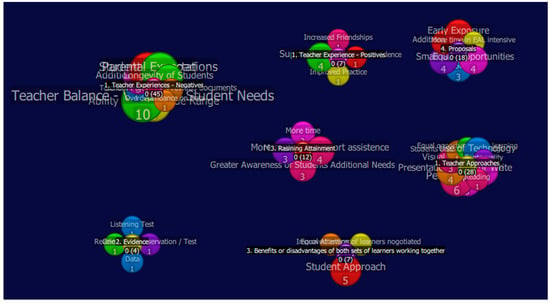
Figure 1.
Quirkos code theme grouping.
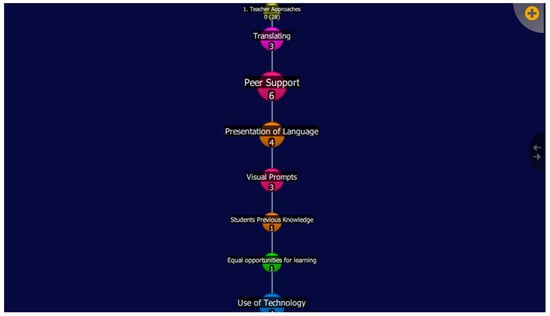
Figure 2.
Quirkos group discussion themes.
Figure 3 illustrates the transfer of data into an Excel spreadsheet.
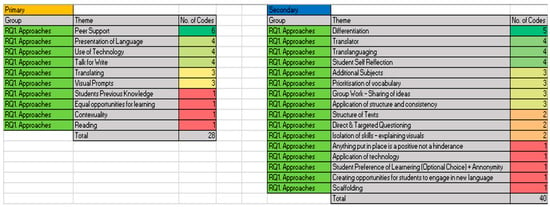
Figure 3.
Quirkos data transferred to an Excel sheet for more clarity.
The researchers employed emergent, thematic, and line-by-line coding to analyze the data [,,]. This granular approach ensured that the data were thoroughly examined while preventing interpretations from taking a broad or generalized stance. This meticulous attention to detail in coding allowed for a deeper understanding of participants’ viewpoints and experiences. The analysis followed a framework analysis approach, involving stages like familiarization with the data, theme identification, indexing, charting, mapping, and final interpretations [,]. The interpretive phenomenological analysis approach (IPA) was used to explore participants’ viewpoints and decision making in teaching native English and EAL students []. IPA was chosen to prioritize the diversity inherent in participants’ lived experiences. This method allowed for a flexible exploration of the context and complexities of these experiences, enabling a deep understanding of the nuances in their viewpoints. By employing a multi-step coding process that incorporates emergent, thematic, and line-by-line coding, followed by a structured framework analysis and IPA, the study aimed to minimize bias, ensure transparency, and uphold the integrity of the findings. The alignment of the chosen methods with the research questions enhances the validity of the analysis, facilitating a robust exploration of the topic. Despite the fact that coding processes have been characterized as inherently subjective, regular meetings were conducted between the two researchers to discuss coding decisions, resolve any discrepancies, and ensure alignment in interpreting the data. To validate the consistency of the coding process, a subset of the data was independently coded by both researchers, to assess the degree of concurrence in the identified themes. The research aimed to provide insights and recommendations for educators and educational institutions based on the findings [].
Ethical Considerations
Prior to commencing the research, ethical considerations were given due attention. Meetings were arranged with the heads of the primary and secondary schools to discuss the research process and obtain written consent from the participants []. These discussions also involved identifying suitable times for the focus group interviews and seeking permission to send confirmation emails and relevant correspondence to the participants prior to the scheduled discussions. During the interactions with the participants, the research aims, data collection methods, and their roles were thoroughly explained, and participants were provided with a participant information sheet and a consent form []. After obtaining consent, the researchers grouped the participants based on their positions in the school, ensuring a balanced representation of both male and female participants. A Doodle link was then sent via email to the participants to facilitate the selection of suitable times for the discussions. Once the schedule was confirmed, a notification email was sent to the participants. Throughout the research, participants were reminded of their right to withdraw from the study at any point if they so wished []. It was emphasized that personal information and data would be treated with confidentiality, and no identifying information would be included in any published study []. All data handling and storage procedures adhered to the guidelines of the General Data Protection Registration (GDPR) to ensure data protection []. To further protect anonymity, participants were assigned codenames during the transcription and analysis process, which allowed for candid responses and contributed to the overall reliability and authenticity of the findings [].
4. Results
The primary objective of the first research question was to gain insight into the prevalent teaching approaches employed by teachers when instructing native English and EAL students in international education. Figure 4 presents the recurring themes that emerged consistently during the three focus group discussions. Notably, the practice of translating in the classroom was identified as the most commonly used approach by teachers to ensure accurate information attainment and effective management of both sets of learners. Additionally, the figure provides a visual representation of the themes that received the highest number of codes across all focus group discussions, emphasizing the significance of peer support for both native English and EAL students, which was considered equally important to the use of translating. Specifically, one participant from the first focus group highlighted that “…one of the things that stood out to me was how the students themselves started forming study groups. They’d gather during breaks and -sometimes- after school, helping each other out with understanding concepts and practicing the language. It’s like they took ownership of their learning process, and it really made a difference…”.
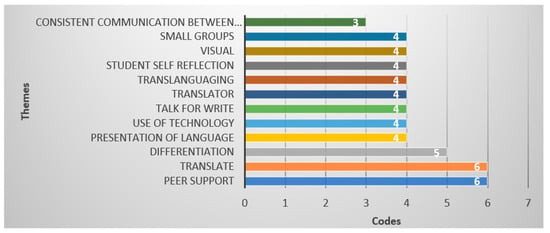
Figure 4.
Most commonly discussed approaches and their frequencies in coding.
In Figure 5, the most extensively discussed themes revolve around the participants’ perceptions of the positives and negatives associated with teaching both native English and EAL students in international education. The predominant theme that emerged was the remarkable support demonstrated by both sets of students, particularly EAL learners, towards each other within the international school setting. A participant from Focus Group 2 mentioned that “… it’s truly heartening to see how our students, both native speakers and those learning English, rally around each other”. Another participant from Focus Group 3 highlighted that “This unity and mutual assistance, especially among EAL students are inspiring to witness”. This support system is evident in their understanding of the challenges of language learning and their willingness to assist one another within the school environment whenever possible. “I feel like the class is really supportive with the EAL students and they kind of see people coming in and think, well I was like that last year, that was me in year three. So, there’s lots of empathy, there’s lots of support in the class and you become this kind of tight unit”, said a participant from the first focus group.
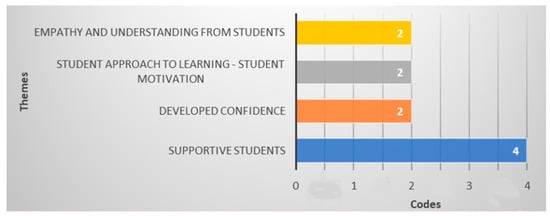
Figure 5.
Most commonly discussed themes regarding positive experiences and their frequencies in coding.
In Figure 6, the most prominently discussed negative themes are depicted, highlighting the challenges associated with balancing the diverse needs of students within international classrooms. The struggle to meet the varied requirements of students significantly impacts their ability to maximize their learning potential. A participant from the second focus group shared their challenges regarding this issue: “What struck me was how differently each student approached the tasks. So, I started tailoring small tasks based on their strengths and weaknesses. It doesn’t always works, but I see that it may impact their performance”. Moreover, the study identified parental expectations and the additional pressures placed on teachers and students as highly significant themes contributing to negative experiences within the context of international education. “…and parents’ expectations of how quickly they’ll pick up the language are obviously varied and again each child is different and they will make that progress in their own time. But that’s something as another kind of element to it that I guess as teachers we have to be answerable to placate parents and their expectations”, said a participant from Focus Group 1.
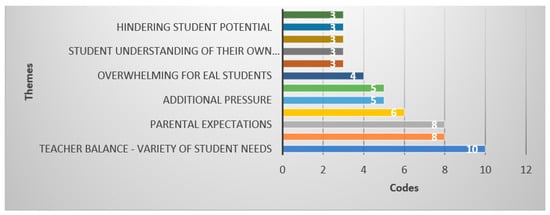
Figure 6.
Most commonly discussed themes regarding negative experiences and their frequencies in coding.
In addressing the second research question, the researchers aimed to understand the approaches and systems employed by educators to record evidence of learning attainment among both native English and EAL learners at international schools. Figure 7 highlights two key themes that emerged as the most frequently discussed methods for evidencing learning attainment. These themes include the use of assessments and negotiated approaches to differentiation, which educators commonly utilized to track the progress of both sets of learners within the international school setting.
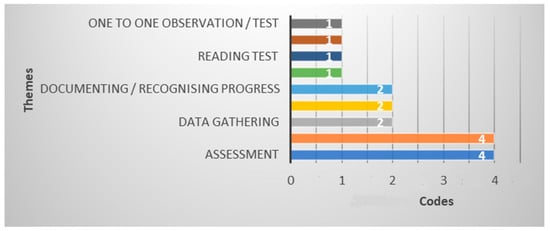
Figure 7.
Most commonly cited evidencing methods and their frequencies in coding.
Figure 8 demonstrates that the emphasis is placed on both the use of assessment and data gathering approaches as the most common approaches used to evidence learning attainment for both sets of learners.
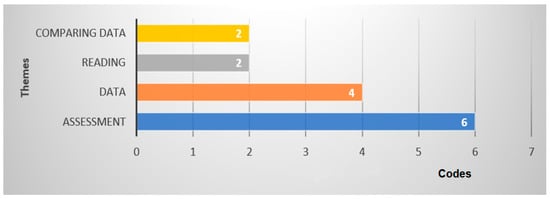
Figure 8.
Commonly cited evidencing methods and their frequencies in coding.
The insights gained from the first two research questions, which explored current approaches and methods of evidencing learning attainment, led to the third research question, which aimed to identify the dominant considerations for improving learning attainment. Figure 9 reveals that the most commonly discussed theme centered around the need for additional support and infrastructure to address the diverse learning needs of students in the classroom. Participants emphasized the importance of providing further social and learning support to cater to the wide variety of learners at international schools. The second most commonly discussed theme was related to time constraints, as educators expressed the need for more support in managing their allocated time in classroom-based learning to effectively address attainment gaps and differences among learners. The following two quotes from Focus Groups 1 and 2 are illustrative: “You have different schedules and also pressure of the curriculum, I think, I don’t know the way around that, but more following the children’s learning and not worrying if you get to that next unit. But then sometimes you can’t do that because the basics need time to be taught”. “… if EAL students feel that their class is a safe space, they are not afraid of participating more and this impacts positively their performance”.
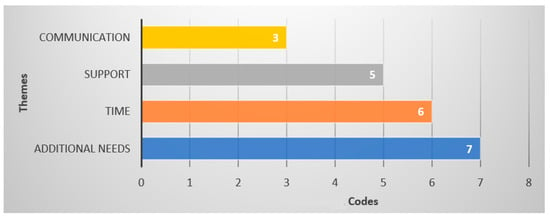
Figure 9.
Commonly discussed issues regarding attainment and their frequencies in coding.
Figure 10 presents a distinct perspective on the most critical aspect to consider for the development of learning attainment, indicating that the revision of student requirements was the most frequently discussed theme, closely followed by the need for the further alignment of the curriculum. This analysis served as a bridge to the fourth research question, which asked participants to propose future developments in the way international education approaches both EAL and native English speakers in the classroom.
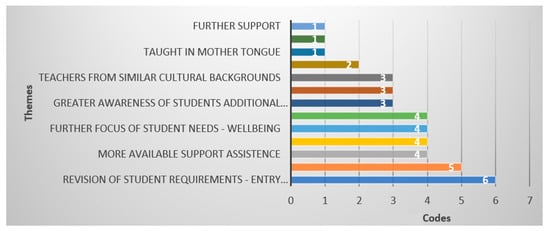
Figure 10.
Most commonly discussed methods for improving attainment and their frequencies in coding.
In Figure 11, the most common method (12) proposed to enhance attainment in English lessons between native English and EAL learners was providing more support to teachers. The next prominent method (8) was additional tuition for students, followed by shared practice among educators (7).
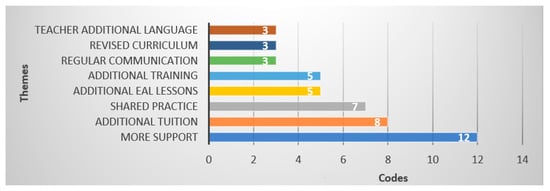
Figure 11.
Commonly cited proposals and their frequency in coding.
Figure 12 reveals that the most widely discussed theme concerning research question 4 was the revision of student requirements before enrollment into the school. Participants suggested this approach with the aim of narrowing the gap in ability levels between EAL and native English speakers, thus creating more manageable classrooms for educators. The second most popular theme was the implementation of small groups, and the third most popular theme was the availability of professional training programs for teachers.
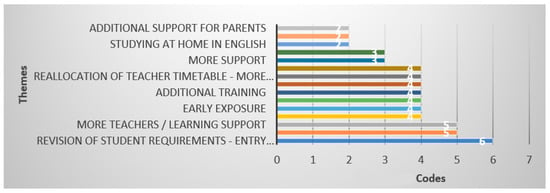
Figure 12.
Most commonly discussed proposals and their frequencies in coding.
5. Discussion
The approach followed in this study allowed the researchers to gain a better understanding of teachers’ current perspectives regarding and approaches to teaching both native English and EAL learners within the context of an international school. It also allowed the researchers to identify and understand the most beneficial methods of developing this area of education further for future considerations. The first research question explored the most effective teaching approaches employed by teachers. Participants highlighted the importance of considering students’ prior knowledge, as it plays a fundamental role in their overall performance [,]. This aligns with constructivist learning theory, where students actively construct knowledge based on their previous experiences [].
The positive experiences of teaching both sets of learners at international schools were closely related to the social support provided by students to one another [,]. This aligns with humanistic learning theories, where student learning is enhanced through social acceptance and interaction []. However, challenges arose when managing the variety of student ability levels in the classroom, and participants emphasized the need for additional support, training, and funding to effectively address these differences [,].
In terms of evidencing learning attainment, assessment and student data collection were the most commonly used methods [,]. These methods align with the importance of learning analytics in monitoring and assessing EAL learners within English lessons []. Participants also suggested revising student entry requirements to minimize language differences between learners and reduce pressure on class teachers [,].
Regarding proposals for future development, revising student entry requirements was considered the most important aspect [,]. The need for more support in the classroom to address the students’ wide range of additional needs was also emphasized []. Online learning resources can support them in their knowledge construction and retention of information []. Participants highlighted the challenge of admitting students at any point during the academic year, with varying degrees of English language proficiency, and the impact it has on classroom attainment [].
Overall, the answers to the four research questions provided insights into the common and consistent themes related to teaching and evidencing learning attainment between native English and EAL learners at international schools. These findings contribute to a better understanding of effective practices and areas for further development in international education. Specifically, the observation of these consistent themes is a pivotal outcome and is particularly notable in its alignment with the initial expectations set by the research design. Given the distinct educational context of international schools, which often encompass a diverse student body, it was anticipated that the responses would reflect certain commonalities in terms of effective teaching practices and patterns of learning attainment among both native English speakers and EAL learners. Furthermore, in line with the existing literature, it was foreseeable that effective approaches to teaching in such diverse settings would involve strategies that promote peer support, individualized approaches, and the recognition of the unique challenges faced by EAL students. Similarly, the shared themes in terms of evidence and support align with the broader educational discourse that emphasizes the importance of holistic assessment and tailored assistance to cater to varying student needs.
6. Conclusions, Limitations, and Future Research
This study demonstrated the benefits of providing participants with the opportunity to express their perceptions through targeted questions, facilitating insightful and thought-provoking discussions among teachers. However, there were limitations to the study, including the small sample size and data collected from a single educational institution. More participants from diverse backgrounds and multiple institutions would have enhanced the data’s reliability and validity. Additionally, extending the duration of discussions would have provided a greater amount of data for analysis.
The first research question revealed that effective teaching approaches included translation, visualization, and group work. Translation methods were used with peer-to-peer or technology-enhanced support to aid learners’ understanding. Visual images and multimedia resources were also vital for EAL learners’ comprehension and vocabulary development. Group work with peer support was effective in achieving lesson objectives.
The second research question highlighted peer support, differentiation, and the use of technology as the highest-rated themes for teaching approaches used for both sets of learners. Collaboration among peers was significant in supporting learners’ progress, while differentiation was crucial in meeting both sets of learners’ attainment needs. Technology played a role in facilitating differentiated instruction, requiring ongoing teacher training and student familiarization.
Teachers’ negative experiences were primarily related to managing the wide range of students’ ability levels, parental expectations, and pressures. To address these challenges, schools should offer more resources and support, promote open communication between parents and teachers, and set clear learning goals.
The third research question explored the methods of properly evidencing learning attainment through assessment. Formative and summative assessments were identified as key methods for measuring learning progress. Teachers need evidence-based good practices and training to select suitable assessment activities.
The fourth research question sought proposals to improve attainment results. Participants suggested revising entry requirements, providing more support to teachers, offering additional EAL lessons, revising the curriculum, and providing further training.
Future research should build upon these findings in various contexts and school units over longer periods to monitor and improve student attainment within English lessons. The study’s implications suggest the need for policy and practice changes to promote equity in education and the inclusion of initiatives in teacher professional development to address the unique needs of EAL students. Consistent discussions within international schools can aid in understanding teachers’ viewpoints on current policies and approaches.
The findings underline the significance of recognizing and addressing the needs of EAL learners. Curriculum policies can be informed by these results to integrate inclusive practices that create equitable learning opportunities for all students. This might involve developing curriculum materials that accommodate varying proficiency levels and incorporating activities that foster cross-cultural understanding. The emphasis on diverse forms of evidence for learning attainment suggests a shift towards holistic assessment approaches. Curriculum reforms could incorporate recommendations from the study to encourage a balanced assessment framework that evaluates not only cognitive achievements but also the development of language skills, critical thinking, and collaborative abilities.
Author Contributions
Conceptualization, L.R.P. and D.V.; methodology, D.V. and L.R.P.; software, L.R.P.; formal analysis, L.R.P.; data curation, L.R.P.; writing—original draft preparation, L.R.P.; writing—review and editing, D.V.; supervision, D.V. All authors have read and agreed to the published version of the manuscript.
Funding
This research received no external funding.
Institutional Review Board Statement
The study was conducted in accordance with the Declaration of Helsinki, and approved by the Institutional Review Board (or Ethics Committee) of University of Essex Online/Kaplan Open Learning (RP-1-20/09/2022).
Informed Consent Statement
Informed consent was obtained from all subjects involved in the study.
Data Availability Statement
The data presented in this study are available on request from the corresponding author. The data are not publicly available due to identity protection/confidentiality reasons.
Conflicts of Interest
The authors declare no conflict of interest.
Appendix A
- Overview
This research project is being conducted at the University of Essex Online. This study aims to explore the following research questions:
- Which teaching approaches do the included teachers provide for native English and EAL students?
- What evidence do the included teachers have regarding the learning attainment of both groups of learners?
- What do the included teachers need to be able to improve the attainment of both groups of students?
- What proposals do the included teachers have to ensure that both groups of students have equal opportunities when studying the English language?
I would like to know your opinion about the way in which native English and EAL students attain information within English lessons at international schools, including highlighting the advantages and disadvantages each group of learners The data presented in this study are available on request from the corresponding author. The data are not publicly available due to identity protection/confidentiality reasons experiences.
Agreements for the participants during the discussion:
- My role as interviewer will be to guide the discussion and provide further clarification on questions when required.
- Please do not interrupt participants or comment until they have finished their statement.
- Please take your time to respond to the discussion.
- You may take a break if required.
- There are no right or wrong answers.
- Please ensure mobile phones are switched off during the discussion.
- Introduction
Researcher to explain the use of the recording devices, confidentiality, and the use of data that will be gathered.
Participant introductions—name, and how our teaching journey brought us to this international position.
Part 1—Which teaching approaches do the included teachers provide for native English and EAL students?
How would the participants describe their teaching experiences, with regard to the positives and negatives of teaching both native English and EAL students within lessons taught in the English language?
- Which teaching approaches do the included teachers provide for native English and EAL students and how effective are these approaches?
Prompting questions for interviewer:—What is your experience like of teaching both native English and EAL learners together within lessons taught in the English language?
- 2.
- Which teaching approaches do you provide for both native English and EAL students in the classroom to ensure learning attainment is achieved as equally as possible?
Prompting questions for interviewer:—What approaches have you used for both sets of learners within the classroom? How have these approaches been effective or ineffective?
- 3.
- Have you had any feedback from the students in your classroom with regard to how they feel about working alongside both sets of learners?
Prompting questions for interviewer:—Was the feedback positive? Was the feedback negative? Do you think this arrangement could be improved at all?
Part 2—What evidence do the included teachers have regarding the learning attainment of both groups of learners?
- 4.
- What approaches or systems are used to record student learning attainment?
Prompting questions for interviewer:—Do you use multiple methods to record learning attainment? Are the approaches to recording learning attainment of both sets of learners different or the same?
Part 3—What do the include teachers need to be able to improve the attainment of both groups of students?
- 5.
- What methods or approaches do you think need to be improved or developed inside and outside of the classroom in order to improve the attainment of both sets of learners?
Prompting questions for interviewer:—Do you think the current approaches used are effective regarding both sets of learners’ learning attainment?
- 6.
- Do you believe that the learning attainment differences between the two sets of learners are hindered when working together within English-led taught lessons?
Prompting questions for interviewer:—Do you think there is a big difference between the ability to satisfy each set of learners’ learning attainment requirements when they are taught together? Do you think one set of learners requires more attention than the other?
Part 4—What proposals do the included teachers have to ensure that both groups of students have equal opportunities when studying the English language?
- 7.
- How could future approaches be developed to ensure that both sets of learners have equal opportunities when studying the English language?
Prompting questions for interviewer:—Do you think the current approaches allow for equal opportunities? Do you think there are any areas in which there are big gaps regarding the opportunities available to each set of learners? How and why do you think this is?
Part 5—Further comments or areas of notable consideration? (open questioning).
- 8.
- Are there any further areas of consideration which you believe we have not covered in this discussion and are worth mentioning with regard to both native English and EAL students’ learning attainment in English lessons?
Prompting questions for interviewer:—Is there anything you believe is worth mentioning that has not yet been covered?
The discussions that we have undertaken have been recorded and will be further transcribed, forming a large part of the data analysis section of this study. Please be assured that all information that you have provided throughout this study will be safely secured and data protection will be adhered to. The perspectives and recommendations that you have highlighted during our discussions will help to further improve our understanding of the way in which native English and EAL students attain information within English lessons at international schools, including highlighting the advantages and disadvantages each group of learners experiences.
- Schedule and Additional Information
The discussions will take place in the xxxx Meeting Room from 16:00–17:30 due to the comfortability, privacy, quietness, and inclusive seating arrangement that it provides.
Audio will be recorded using multiple devices, including the voice recorder application on two iPhones and an iPad, alongside a microphone and the digital audio recording software Logic Pro on an Apple MacBook. The reason for recording the conversations on multiple devices is to ensure that if one application fails, then there will be back up recordings.
All software and audio recording equipment has been revised and practiced prior to the discussion, to ensure its suitability and reliability.
Snacks and drinks will be provided by the researcher.
Each focus group should aim to fill 90 min of their time, aiming to complete the discussions within 60–70 min, with a break if necessary.
Appendix B
- Participant Information Sheet
I, XXX, invite you to participate in a research study undertaken at the University of Essex, United Kingdom.
- Title of the Study
Teachers’ perceptions on learning attainment in English lessons between native English speakers and English as an additional language (EAL) students at an international school.
- Overview
I would like to know your opinion of the way in which native English and EAL students attain information within English lessons at international schools, including highlighting the advantages and disadvantages each group of learners experiences.
This study aims to explore the following research questions:
- Which teaching approaches do the included teachers provide for native English and EAL students?
- What evidence do the included teachers have regarding the learning attainment of both groups of learners?
- What do the included teachers need to be able to improve the attainment of both groups of students?
- What proposals do the included teachers have to ensure that both groups of students have equal opportunities when studying the English language?
- Research Activity
The data from this research will be collected through semi-structured interviews in the form of three focus groups of five or six teachers. The focus group interviews will be audio recorded and transcribed in order to allow further opportunities for the researcher to analyze the data after the interviews have been undertaken. No video recording will be used.
- Key Information for Participants
Your participation is voluntary within this data collection process.
You have the right to refuse participation and withdraw at any time without consequence.
There are no risks or benefits to you regarding your participation in this study.
This research study is entirely independent of xxxx International School.
This will not affect your position at the school or any of your roles and responsibilities associated with xxxx.
Personal information and data will be strictly confidential.
You are entitled to access the information you have provided at any time.
- Contact Information
Email:
Research Supervisor:
Email:
References
- Finkelstein, S.; Sharma, U.; Furlonger, B. The inclusive practices of classroom teachers: A scoping review and thematic analysis. Int. J. Incl. Educ. 2021, 25, 735–762. [Google Scholar] [CrossRef]
- Flockton, G.; Cunningham, C. Teacher educators’ perspectives on preparing student teachers to work with pupils who speak languages beyond English. J. Educ. Teach. 2021, 47, 220–233. [Google Scholar] [CrossRef]
- Bailey, L.; Sowden, H. Reflective accounts of teaching literacy to pupils with English as an additional language (EAL) in primary education. Res. J. Natl. Assoc. Teach. Engl. 2019, 55, 286–300. [Google Scholar] [CrossRef]
- Hagger, M.S. Grit and self-discipline as predictors of effort and academic attainment. Br. J. Educ. Psychol. 2018, 89, 324–342. [Google Scholar] [CrossRef]
- Bogulksi, C.; Bice, K.; Kroll, J. Bilingualism as a Desirable Difficult: Advantages In Word Learning Depend On Regulation Of The Dominant Language. Biling. Lang. Cogn. 2018, 22, 1052–1067. [Google Scholar]
- Chuang, H.H.; Weng, C.Y.; Chen, C.H. Which Students Benefit Most from A Flipped Classroom Approach to Language Learning. Br. J. Educ. Technol. 2018, 49, 56–68. [Google Scholar] [CrossRef]
- Dos Santos, L.M. Discussion of Communicative Language Teaching Approach in Language Classrooms. J. Educ. E-Learn. Res. 2020, 7, 104–109. [Google Scholar] [CrossRef]
- Fadlallah, R.; El-Harakeh, A.; Bou-Karroum, L.; Lotfi, T.; El-Jardali, F.; Hishi, L.; Akl, E.A. A Common Framework of Steps and Criteria For Prioritizing Topics For Evidence Syntheses: A Systematic Review. J. Clin. Epidemiol. 2020, 120, 67–85. [Google Scholar] [CrossRef]
- Coe, R.; Waring, M.; Hedges, L.V.; Ashley, L.D. Research Methods and Methodologies in Education; SAGE: London, UK, 2021. [Google Scholar]
- Wijayanti, E.; Mujiyanto, Y.; Pratama, H. The Influence of The Teachers’ Reading Habbit On Their Teaching Practice: A Narrative Inquiry. Engl. Educ. J. 2022, 12, 205–214. [Google Scholar]
- Brown, D.; Fallin, L. Literature Review. In Getting Started in Your Educational Research: Design, Data Production and Analysis; Opie, C., Brown, D., Eds.; SAGE: London, UK, 2019. [Google Scholar]
- Salvador-Oliván, J.A.; Marco-Cuenca, G.; Arquero-Avilés, R. Errors in Search Strategies Used In Systematic Reviews And Their Effects On Information Retrieval. J. Med. Libr. Assoc. 2019, 107, 210–221. [Google Scholar] [CrossRef]
- Dixon, C.; Hessel, A.; Smith, N.; Nielsen, D.; Wesierska, M.; Oxley, E. Receptive and expressive vocabulary development in children learning English as an additional language: Converging evidence from multiple datasets. J. Child Lang. 2022, 50, 610–631. [Google Scholar] [CrossRef]
- Kane, F.; Kennedy, L.; Sevdali; Folli, R.; Rhys, C. Language made fun: Supporting EAL students in primary education. Teanga 2019, 10, 113–125. [Google Scholar] [CrossRef]
- Chalmers, H. Leveraging the L1: The Role of EAL Learners’ First Language in Their Acquisition of English Vocabulary. Ph.D. Thesis, University of Oxford, Oxford, UK, 2019; 296p. [Google Scholar]
- Creagh, S.; Kettle, M.; Alford, J.; Comber, B.; Shield, P. How long does it take to achieve academically in a second language?: Comparing the trajectories of EAL students and first language peers in Queensland schools. Aust. J. Lang. Lit. 2019, 42, 145–155. [Google Scholar] [CrossRef]
- Schneider, C.; Arnot, M. An exploration of school communication approaches for newly arrived EAL students: Applying three dimensions of organisational communication theory. Camb. J. Educ. 2018, 48, 245–262. [Google Scholar] [CrossRef]
- Forbes, K. The role of individual differences in the development and transfer of writing strategies between foreign and first language classrooms. Res. Pap. Educ. 2019, 34, 445–464. [Google Scholar] [CrossRef]
- Babayigit, S.; Shapiro, L. Component skills that underpin listening comprehension and reading comprehension in learners with English as first and additional languages. J. Res. Read. 2019, 43, 78–97. [Google Scholar] [CrossRef]
- Kosar, G.; Bedir, H. Improving Knowledge Retention Via Establishing Brain-Based Learning Environment. Eur. J. Educ. Stud. 2018, 4, 208–218. [Google Scholar]
- Chumak-Horbatsch, R. Using Linguistically Appropriate Practice: A Guide for Teaching in Multilingual Classrooms; Multilingual Matters: Bristol, UK, 2019. [Google Scholar]
- Conteh, J. The EAL Teaching Book: Promoting Success for Multilingual Learners; Learning Matters: London, UK, 2019. [Google Scholar]
- Costley, T.; Gkonou, C.; Myles, F.; Roehr-Brackin, K.; Tellier, A. Multilingual and monolingual children in the primary-level language classroom: Individual differences and perceptions of foreign language learning. Lang. Learn. J. 2020, 48, 643–655. [Google Scholar] [CrossRef]
- Sinclair, J.C.; Law, C. Initial assessment for K-12 English language support in six countries: Revisiting the validity-reliability paradox. Lang. Educ. 2018, 32, 257–285. [Google Scholar] [CrossRef]
- Hamed, M.; Fadhil, T. Teaching English in Elqubba Primary Schools: Issues and Directions. J. Educ. Learn. 2019, 13, 410–415. [Google Scholar] [CrossRef]
- Demie, F. English language proficiency and attainment of EAL (English as second language) pupils in England. J. Multiling. Multicult. Dev. 2018, 39, 641–653. [Google Scholar] [CrossRef]
- Zelinsky, T.; Hudec, O.; Mojsejova, A.; Hricova, S. The effects of population density on subjective well-being: A case-study of Slovakia. Socio-Econ. Plan. Sci. 2021, 78, 101061. [Google Scholar] [CrossRef]
- Zahorec, J.; Haskova, A.; Munk, M. Self-Reflection of Digital Literacy of Primary and Secondary School Teachers: Case Study of Slovakia. Eur. J. Contemp. Educ. 2021, 10, 496–508. [Google Scholar]
- Butterworth, A. Issues in Roma Education: The Relationship Between Language and the Educational Needs of Roma Students. Res. Teach. Educ. 2019, 9, 34–38. [Google Scholar]
- Noman, M.; Gurr, D. Contextual Leadership and Culture in Education. In Oxford Research Encyclopedia of Education; Oxford University Press: Oxford, UK, 2020. [Google Scholar]
- Toropova, A.; Myrberg, E.; Johansson, S. Teacher job satisfaction: The importance of school working conditions and teacher characteristics. Educ. Rev. 2019, 73, 71–97. [Google Scholar] [CrossRef]
- Hanifa, R. Factors generating anxiety when learning EFL speaking skills. Stud. Engl. Lang. Educ. 2018, 5, 230–239. [Google Scholar] [CrossRef]
- Sallang, H.; Ling, Y.L. The Importance of Immediate Constructive Feedback on Students’ Instrumental Motivation in Speaking in English. Br. Int. Linguist. Arts Educ. Sci. J. 2019, 1, 1–7. [Google Scholar] [CrossRef]
- Piller, I.; Gerber, L. Family language policy between the bilingual advantage and the monolingual mindset. Int. J. Biling. Educ. Biling. 2018, 24, 622–635. [Google Scholar] [CrossRef]
- Brooks, J.S.; Heffernan, A. The School Leadership Survival Guide: What to Do When Things Go Wrong, How to Learn from Mistakes, and Why You Should Prepare for the Worst; IAP: Charlotte, NC, USA, 2021. [Google Scholar]
- Epstein, J.L. School, family, and community partnerships in teachers’ professional work. J. Educ. Teach. 2018, 44, 397–406. [Google Scholar] [CrossRef]
- Papi, M.; Hiver, P. Language Learning Motivation as a Complex Dynamic System: A Global Perspective of Truth, Control, and Value. Mod. Lang. J. 2020, 104, 209–232. [Google Scholar] [CrossRef]
- Alzeebaree, Y.; Hasan, A.I. What Makes an Effective EFL Teacher: High School Students’ Perceptions. Asian ESP J. 2021, 16, 169–183. [Google Scholar]
- Al-Shammari, Z.; Faulkner, P.E.; Forlin, C. Theories-based Inclusive Education Practices. Educ. Q. Rev. 2019, 2, 408–414. [Google Scholar] [CrossRef]
- Naibaho, L. Teachers’ Roles On English Language Teaching: A Students Centred Learning Approach. Int. J. Res. 2019, 7, 206–212. [Google Scholar] [CrossRef]
- Howitt, L. Language, Identity and the School Curriculum: Challenges and Opportunities for Students with English as an Additional Language (EAL) in ‘Lowincidence’ Secondary School Contexts. Doctoral Thesis, Northumbria University, Newcastle upon Tyne, UK, 2022. [Google Scholar]
- Ainscow, M. Promoting inclusion and equity in education: Lessons from international experiences. Nord. J. Stud. Educ. Policy 2020, 6, 7–16. [Google Scholar] [CrossRef]
- Abramova, G.S.; Mashoshina, V.S. On Differentiation Strategies in the EFL Mixed-Ability Classroom: Towards Promoting the Synergistic Learning Environment. Eur. J. Contemp. Educ. 2021, 10, 558–573. [Google Scholar]
- Hanushek, E.A. Chapter 13—Education production functions. In The Economics of Education, 2nd ed.; Bradley, S., Green, C., Eds.; Academic Press: Cambridge, MA, USA, 2020; pp. 161–170. [Google Scholar]
- Shah, R.K. Effective Constructivist Teaching Learning in the Classroom. Shanlax Int. J. Educ. 2019, 7, 1–13. [Google Scholar] [CrossRef]
- Liang, H.; Li, X. Research on Innovation Method of College English Translation Teaching Under the Concept of Constructivism. Educ. Sci. Theory Pract. 2018, 18, 2455–2461. [Google Scholar]
- Akinyode, B.F.; Khan, T.H. Step by step approach for qualitative data analysis. Int. J. Built Environ. Sustain. 2018, 5, 163–174. [Google Scholar] [CrossRef]
- Sölpük Turhan, N. Qualitative Research Designs: Which One is the Best for Your Research? Eur. J. Spec. Educ. Res. 2019, 4. [Google Scholar]
- Lee, M.; Louis, K.S. Mapping a strong school culture and linking it to sustainable school improvement. Teach. Teach. Educ. 2019, 81, 84–96. [Google Scholar] [CrossRef]
- McEwan, B. Sampling and Validity. Ann. Int. Commun. Assoc. 2020, 44, 235–247. [Google Scholar] [CrossRef]
- Mweshi, G.K.; Sakyi, K. Application of Sampling Methods for The Research Design. Arch. Bus. Res. 2020, 8, 180–193. [Google Scholar] [CrossRef]
- O.Nyumba, T.; Wilson, K.; Derrick, C.J.; Mukherjee, N. The use of focus group discussion methodology: Insights from two decades of application in conservation. Methods Ecol. Evol. 2018, 9, 20–32. [Google Scholar] [CrossRef]
- Bajec, B. Relationship between time perspective and time management behaviours. Psihologija 2019, 52, 197–215. [Google Scholar] [CrossRef]
- Flick, U. The SAGE Handbook of Qualitative Data Collection; SAGE: London, UK, 2017. [Google Scholar]
- Young, J.C.; Rose, D.C.; Mumby, H.S.; Benitez-Capistros, F.; Derrick, C.J.; Finch, T.; Garcia, C.; Home, C.; Marwaha, E.; Morgans, C.; et al. A methodological guide to using and reporting on interviews in conservation science research. Methods Ecol. Evol. 2018, 9, 10–19. [Google Scholar] [CrossRef]
- Buchanan, D.; Warwick, I. First do no harm: Using ‘ethical triage’ to minimise causing harm when undertaking educational research among vulnerable participants. J. Furth. High. Educ. 2021, 45, 1090–1103. [Google Scholar] [CrossRef]
- Pardo Soto, C.V.; Cisterna Zenteno, C. Smartphone Screen Recording Apps: An Effective Tool to Enhance Fluency in the English Language. Colomb. Appl. Linguist. J. 2019, 21, 208–229. [Google Scholar] [CrossRef]
- Henderson, H. Difficult questions of difficult questions: The role of the researcher and transcription styles. Int. J. Qual. Stud. Educ. 2018, 31, 143–157. [Google Scholar] [CrossRef]
- Vindrola-Padros, C.; Johnson, G.A. Rapid Techniques in Qualitative Research: A Critical Review of the Literature. Qual. Health Res. 2020, 30, 1596–1604. [Google Scholar] [CrossRef]
- Greckhamer, T.; Furnari, S.; Fiss, P.C.; Aguilera, R.V. Studying configurations with qualitative comparative analysis: Best practices in strategy and organization research. Strateg. Organ. 2018, 16, 482–495. [Google Scholar] [CrossRef]
- Williams, M.; Moser, T. The Art of Coding and Thematic Exploration in Qualitative Research. Int. Manag. Rev. 2019, 15, 45–55. [Google Scholar]
- Deterding, N.M.; Waters, M.C. Flexible Coding of In-depth Interviews: A Twenty-first-century Approach. Sociol. Methods Res. 2018, 50, 708–739. [Google Scholar] [CrossRef]
- Peel, K.L. A Beginner A Beginner’s Guide to Applied Educational Research using Thematic Analysis. Pract. Assess. Res. Eval. 2020, 25, 1–15. [Google Scholar]
- Miller, R.M.; Chan, C.D.; Farmer, L.B. Interpretative Phenomenological Analysis: A Contemporary Qualitative Approach. Couns. Educ. Superv. 2018, 57, 240–254. [Google Scholar] [CrossRef]
- BERA. Ethics and Guidance. 2018. Available online: https://www.bera.ac.uk/resources/all-publications/resources-for-researchers (accessed on 10 July 2023).
- Sim, J.; Waterfield, J. Focus group methodology: Some ethical challenges. Qual. Quant. 2019, 53, 3003–3022. [Google Scholar] [CrossRef]
- Muhajirah, M. Basic of Learning Theory. Int. J. Asian Educ. 2020, 1, 37–42. [Google Scholar] [CrossRef]
- Tolstova, O.; Levasheva, Y. Humanistic trend in education in a global context. SHS Web Conf. 2019, 69, 00121. [Google Scholar] [CrossRef]
- Dixon, C.; Thomson, J.; Fricke, S. Language and reading development in children learning English as an additional language in primary school in England. J. Res. Read. 2020, 43, 309–328. [Google Scholar] [CrossRef]
- Magableh, I.S.I.; Abdullah, A. The Impact of Differentiated Instruction on Students’ Reading Comprehension Attainment in Mixed-Ability Classrooms. Interchange 2021, 52, 255–272. [Google Scholar] [CrossRef]
- McGuinness, N.; Vlachopoulos, D. Student Experiences of Using Online Material to Support Success in A-Level Economics. Int. J. Emerg. Technol. Learn. 2021, 14, 80–109. [Google Scholar] [CrossRef]
Disclaimer/Publisher’s Note: The statements, opinions and data contained in all publications are solely those of the individual author(s) and contributor(s) and not of MDPI and/or the editor(s). MDPI and/or the editor(s) disclaim responsibility for any injury to people or property resulting from any ideas, methods, instructions or products referred to in the content. |
© 2023 by the authors. Licensee MDPI, Basel, Switzerland. This article is an open access article distributed under the terms and conditions of the Creative Commons Attribution (CC BY) license (https://creativecommons.org/licenses/by/4.0/).